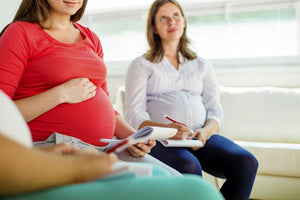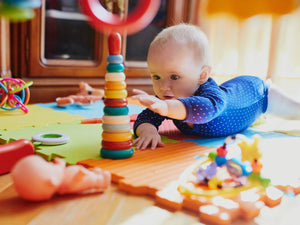Many of us have heard of babies having hip dysplasia, congenital dislocation of the hips, or perhaps even “clicky hips”. But understanding what’s involved can be a little confusing.
The correct name for hip dysplasia is Developmental Dysplasia of the Hip (DDH). This is because it can develop after a baby is born and isn’t always present at birth. That’s why it’s so important for babies to have their hips checked regularly, right up to their first birthday.
What’s Normal?
Hips work by using a ball and socket mechanism. The top of the femur (thigh bone) is shaped like a ball and fits into the socket (acetabulum) which is part of the pelvis.
Ligaments and muscles help to keep the ball and socket held securely so the structures in the hip joint stay well supported. If the ball and socket fit isn’t tight and/or the ligaments are loose, then the hip isn’t secure and can dislocate.
What Exactly is DDH?
Babies with DDH have an abnormal development of one or both of their hip joints.
A combination of factors contributes to DDH
- At birth, hip joints aren’t yet bone, but very soft cartilage.
- The ligaments which support them are loose because of the effect of the mother’s pregnancy hormones.
- At birth, the socket can be very shallow.
What are the Signs of DDH?
You may not know that your baby has DDH until they are examined by a doctor or a child health nurse. Two of the most common assessments done by health practitioners are the Barlow and Ortolani tests.
- Hearing a “clunk” or a “click” when the hips moves is a warning sign of DDH.
- Other observations are done as well, including checking the baby’s legs are equal length, if they have symmetrical creases on their thighs and bottom, and also if their legs abduct (move away from each other) easily and equally.
- Babies who are old enough to sit up and have DDH may tend to move their weight to one side when sitting. Older children can be reluctant to bear weight on their legs or walk on tippy toes on one side. Some will actually limp when they are walking and protest to be carried or pushed in their pram.
- Torticollis (twisted neck), plagiocephaly and metatarsus adductus are also warning signs of having DDH as well.
Diagnosis of DDH
If there is any suspicion that a baby may have DDH, they are sent for an ultrasound and/or an X-ray. Generally an ultrasound is done between 6 weeks -6 months of life and an X-ray if the baby is aged over 6 months.
Top Five Facts about Hip Dysplasia
- It affects more girls than boys.
- Around 1 in every 6 full-term newborn babies has some degree of hip instability. And up to 1 in every 50 babies is having treatment for DDH.
- Hip dysplasia is the most common cause for adults to have hip arthritis.
- Hip dysplasia can be missed, so checking at regular ages is important.
- The left hip is more frequently affected by DDH than the right hip.
DDH is Silent
Babies with DDH don’t give away too many clues and the symptoms of DDH can be subtle. That’s why it’s important for the adults in their lives and health practitioners to know what to look for.
There is a wide range of severity with DDH, from subluxation – where the ball isn’t centred in the hip socket, to actual dislocation – where the ball becomes slightly or completely dislocated from the socket.
Pain from DDH doesn’t really start until around 13-14 years of age when treatment is not as straightforward. This is when early arthritis can start causing symptoms. So early diagnosis and treatment, if warranted, is really important.
Treatment for DDH
The earlier the diagnosis of DDH, the better. The aim of treatment is to hold the hip in the socket until the ligaments surrounding it strengthen. Splints are commonly used, because they give time for the socket and bone to grow to their correct shape. There are several different styles of splints and each is designed to suit the degree of DDH. Splints are generally worn night and day, depending on the severity.
If a splint isn’t effective or the DDH is very severe, surgery is sometimes necessary. There is a range of surgical options but essentially surgery is designed to strengthen the ligaments which may be too loose, relax the muscles which may be too tight, and help to shape the hip and thigh bones so they are better aligned.
What Else do I Need to Know About DDH?
- Check your own family history for hip dysplasia. DDH is 12 times more likely when there is a family history. There is a genetic tendency to have this condition, especially when a first degree relative e.g. baby’s mother/father, sibling had DDH.
- If your baby was a breech birth then they are at increased risk of DDH. This is because a baby’s womb position can place extra pressure on their hips.
- First born babies are at more risk.
- Babies with a neuromuscular or connective tissue disorder are in a higher risk category.
- Tight or inappropriate swaddling changes the normal position of the hips. When a baby’s legs are in their normal position, the hip muscles stabilise the joint.
- Baby carriers/pouches/slings need to support the baby’s thighs to the knee joint. Otherwise their legs aren’t spread so their hips are in a stable, correct position.
When Should my Baby be Checked for DDH?
Every baby’s hips need to be checked regularly, particularly if there are any risk factors present.
Every doctor’s visit for at least the first year of life is a good practice.
- Birth
- 1-4 weeks
- 6-8 weeks
- 6-9 months
- 12 months
Who do I Need to see About my Baby’s DDH?
- A GP or your Child Health Nurse
- A paediatric orthopaedic surgeon
- A paediatric physiotherapist who specialises in paediatrics (children)
- A radiologist and/or sonographer
For more information on DDH Check
Healthy Hips Australia
The International Hip Dysplasia Institute
About the Author:
Jane Barry has qualifications in general, paediatric, immunisation, midwifery and child health nursing. She holds a Bachelor Degree in Applied Science (Nursing) and has almost 30 years specialist experience in child health nursing. She is a member of a number of professionally affiliated organisations including AHPRA, The Australasian Medical Writer’s Association, Health Writer Hub and Australian College of Children and Young People’s Nurses.
Our Products
-

01. Guide to a Healthy Pregnancy
$55 -

02. Positive Birthing Course
$55 -

03. Infant Feeding Guide
$55 -

04. Baby Sleep Guide - First 12 Months
$55 -

05. Toddler Parenting Course 1 - 3 Years
$55
-
 When to Start Antenatal Classes?
When to Start Antenatal Classes?
Becoming a parent is an incredible milestone, but it comes with a host of changes that can be daunting, especially for first time parents. Antenatal classes are all about offering expectant parents the education they need to make informed decisions, look after their bodies and care for their newborn babies. While you probably already have a long list of things you need to accomplish during your pregnancy, it’s a good idea to make time to attend antenatal classes.
-
 Development Milestones 4-8 Months
Development Milestones 4-8 Months
As they reach the middle of their first year, you'll start to see bigger leaps in their growth and ability!
In this article, we’re going to discuss your baby’s developmental milestones between 4-8 months, and what you can expect along the way.





 When to Start Antenatal Classes?
When to Start Antenatal Classes?
 Development Milestones 4-8 Months
Development Milestones 4-8 Months








